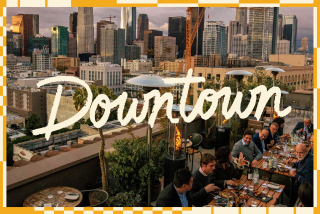Itâs About Constructing a Cultural Legacy
Uri D. Herscher, president of the Skirball Cultural Center, doesnât like to talk about buildings.
âYou want to talk about the building? I will talk about the building. I am hesitant to talk about the building,â he begins, during a conversation at the Skirball, nestled in the Sepulveda Pass just north of the Getty Center. âBecause as much as I appreciate gorgeous envelopes, as time goes on, they seem to matter less and less. Itâs the contents within the buildings.â
This all-sides-considered prologue is typical of Herscher, who always manages to create the aura of a democratic round-table discussion even when heâs the only one talking. Trained as a rabbi and scholar, he builds communities, not structures of concrete and steel.
Herscher has been not talking about buildings ever since the $73-million Skirball Cultural Center opened in the spring of 1996 with a stated mission to âinterpret the Jewish experience, to nurture Jewish identity and strengthen American society.â
In the course of the centerâs five years, Herscher has changed that statement to read: âThe Skirball Center is dedicated to exploring connections between four thousand years of Jewish heritage and the vitality of Americaâs democratic ideals.â On a printed copy, the word âdemocraticâ is written in by hand--another indication that the Skirballâs mission continues to evolve.
Still--even if he doesnât like to talk about it--the evolution of the Skirball includes a new building: the $45-million Ahmanson Hall, a multipurpose space dedicated to the memory of civic and cultural leader Franklin D. Murphy.
Ahmanson Hall was scheduled to open its doors to the public for the first time Saturday with a dance piece performed by Liz Lermanâs Maryland-based Dance Exchange, exploring the Buddhist, Christian and Jewish communities and what each group finds itself celebrating at the beginning of the millennium. The piece, which is scheduled to be performed again tonight, is part of Lermanâs nationwide âHallelujah Project.â Representatives of local Buddhist temples, Jewish temples and Christian churches are participating in the show.
Completed in January, Ahmanson Hall, named for the Ahmanson Foundation, which supported the hall and other projects at the center, represents Phase II of construction on the centerâs 15-acre campus, whose buildings are designed by architect Moshe Safdie. The 20,000-square-foot, dome-ceilinged hall houses an auditorium that can be transformed from an open space for a standing crowd of up to 1,200, to a tiered-seating theater for up to 515. The lower level also contains a business center and multipurpose rooms that can serve as dressing rooms, rehearsal areas or meeting rooms.
State-of-the-art sound and audiovisual systems are permanently installed, so the auditorium will not have to be rigged with imported technical equipment for performances.
Ahmanson Hall is not the last building Herscher is going to have to talk about. Phase III is the Winnick American Family Heritage Hall, which will be used to expand the activities of the childrenâs Discovery Center in the main building. Estimated to cost $34 million, the facility is scheduled to open its doors in 2003. Winnick Hall will also have an outdoor amphitheater for childrenâs performances.
Children are important to the Skirball. Of the more than 2 million visitors to the center since it opened, 200,000 have been children, most of them from Los Angeles public schools. The center is closed to other visitors from 9 a.m. to noon, and the Skirball provides and funds the bus transportation to get the children there.
âWhen the center opened, I would have said that our focus was children 1 day old and onward,â Herscher says. âToday the target is 2-year-olds to maybe 9-year-olds--with a focused idea that if we donât introduce all of these values, democratic ideals, to youngsters, itâs just too late.â
When Winnick Hall is finished, the Skirball construction costs will total $152 million. And, with about 450,000 square feet, it will become the largest Jewish cultural institution in North America.
Along with its square footage, the centerâs annual operating budget has grown--from $3.5 million to $10 million, most of it spent on developing programs and expanding staff rather than the physical plant. Herscherâs philosophy is the opposite of âif you build it, they will comeâ: If they come, he says, then you build. Putting programs first, Herscher says, is the reason the center needed to add Ahmanson Hall and more performance space to the campus.
*
The new auditorium, named for businessman and donor Lloyd Cotsen, is a complement to the 350-seat Magnin Auditorium, housed in the main building along with the exhibition galleries, store and cafe. Magnin hosts the L.A. Theatre Works radio theater series, as well as lectures, dance concerts, movie screenings, readings, and âconversationsâ with guests including artist George Segal, writer Richard Rodriguez, playwrights Neil Simon and Wendy Wasserstein, and TV producer Norman Lear.
Herscher says that Cotsen Auditorium will serve two functions: It will allow for more of the same type of programming that Magnin hosts, and it will provide a year-round home for certain types of performances the center has so far only been able to hold in the summer in the outdoor Taper Courtyard adjacent to the main building.
That programming includes the Sunset Concert Series, which began as a cafe series inside the main buildingâs restaurant five years ago and moved outdoors in 1998 as the audience continued to expand. The series includes world music, classical and jazz fusion concerts. Since 1998, program associate and music programmer Yatrika Shah-Rais--also one of the hosts of the multicultural music program âGlobal Villageâ weekday mornings on KPFK-FM (90.7)--has been expanding the program to include a greater proportion of world music.
âWhen Yatrika came to me and suggested a world music program, I said, âWhatâs world music?â â Herscher says. âNow attendance at these concerts has crossed all socioeconomic lines. We are drawing audiences of 1,500 per concert.â
Ahmanson Hall will also be available for Jewish and non-Jewish âlife cycleâ events, including weddings, quinceanera celebrations and bar mitzvahs, or humanitarian activities, such as fund-raisers for disease research. But there are limits to the possibilities.
âWhat weâve attempted to do here is all mission-related and excellence-related,â Herscher says. We have a wonderful venue, weâre happy to share it a much as we can with like-minded people with communal ideas as focused within their mission as within our mission.â
The same holds true for artistic performances, he adds. âThe idea of having the L.A. Philharmonic [or other performing arts groups] here is conditioned on the fact that it needs to be a teaching experience,â Herscher says. âTo go listen to a wonderful piece of music is OK, but frankly I was not born with music in my home; I need some kind of prologue to the piece. I wonât have anyone play here without the context.â
*
Next up for Ahmanson Hall after the Lerman performances is World Mosaic, a concert series featuring music from around the world. On April 26, the hall will host Axiom of Choice, a Los Angeles-based cross-cultural ensemble that blends the sounds and traditional instruments of Persian, Eastern and Western music. Shesh Besh, an ensemble of five Israeli musicians who combine Western and Middle Eastern classical and folk traditions, will perform May 10. Musicians Pandit Shivkumar Sharma, who plays the santoor (hammered dulcimer), and percussionist Ustad Zakir Hussain perform May 23-24.
Other performers scheduled are L. Shankar and Hussain (Oct. 4 and 5); composer Stephen Schwartz (Oct. 7); Paul Winter, Oscar Castro Nieves and Arto Tuncboyacain (Nov. 18); and Habib Kolte (Feb. 20, 2002).
Associate program director Jordan Peimer, who handles dance programming, says the Skirball is waiting to gauge the response to the Lerman company before committing to a full dance schedule. Among the performers under consideration: Copenhagenâs Hotel Pro Forma, a multimedia performance troupe that combines projections, text and voice; choreographer Jose Navas, director of Montrealâs Compagnie Flak, performing with a solo cellist; and a piece by British choreographer Wendy Houstoun thatâs performed in a nightclub setting.
âSome things need to be seen on a large stage, from a distance--Iâm interested in presenting performers who can benefit from the intimacy of being seen up close,â Peimer says. âIâd like to bring in the kinds of performances that have been seen around the world, but havenât been seen here--they may get to New York but certainly never get to L.A.. I think weâve had a real dearth of mid-career performers and companies that are really at their creative best.â Peimer also sees the space as a natural for helping local performing artists to develop.
Along with serving as the catalyst for new programming, Ahmanson Hall plays a symbolic role in furthering the centerâs mission, Herscher says. âVery often when we tell people about the auditorium, they say, âWe didnât know Ahmanson was Jewish!â And we say, âWell heâs not!â The idea that only Jews would support a Jewish institution is exactly what weâre trying to break down,â Herscher says. âWhen you have the names [of donors including] Ahmanson, Parsons and Getty scattered throughout the center, thereâs a very important message.
âMost Jewish institutions serve the Jewish people. This institution serves all people.â
*
Skirball Cultural Center, 2701 North Sepulveda Blvd., Los Angeles. Program information: (310) 440-4500 or www.skirball.org.
More to Read
The biggest entertainment stories
Get our big stories about Hollywood, film, television, music, arts, culture and more right in your inbox as soon as they publish.
You may occasionally receive promotional content from the Los Angeles Times.










